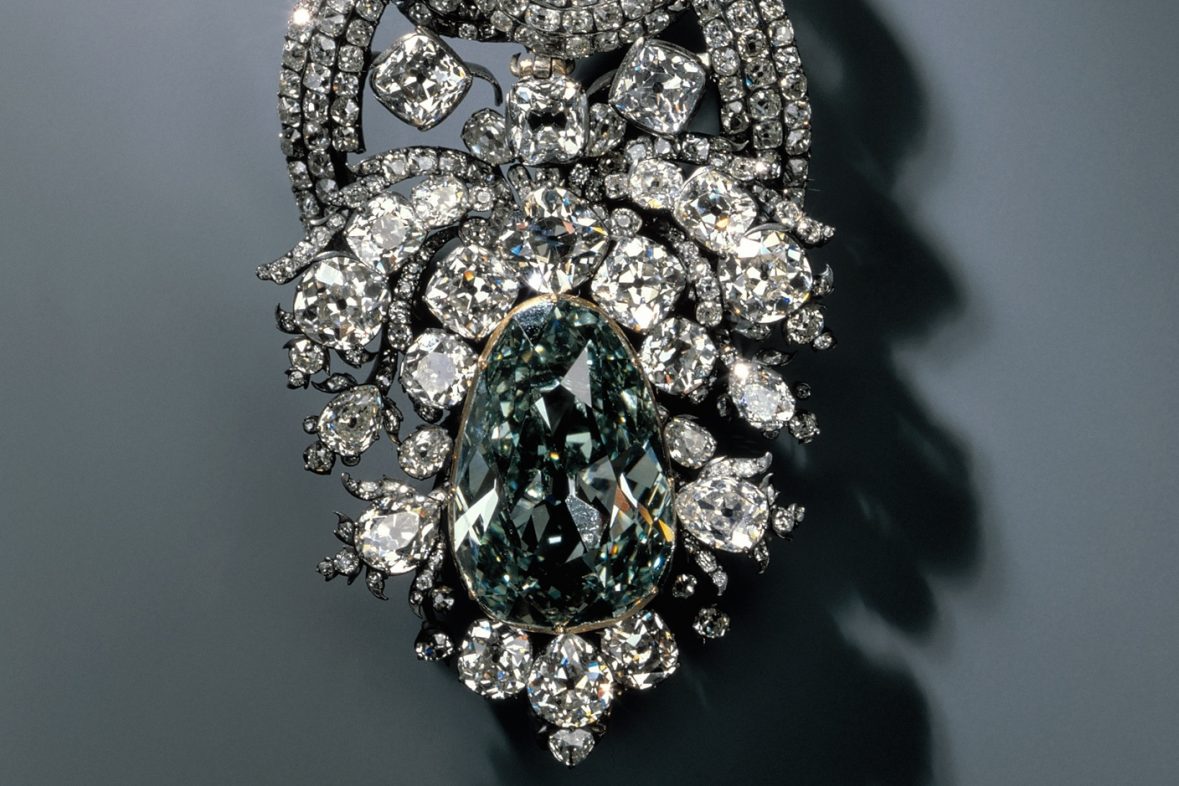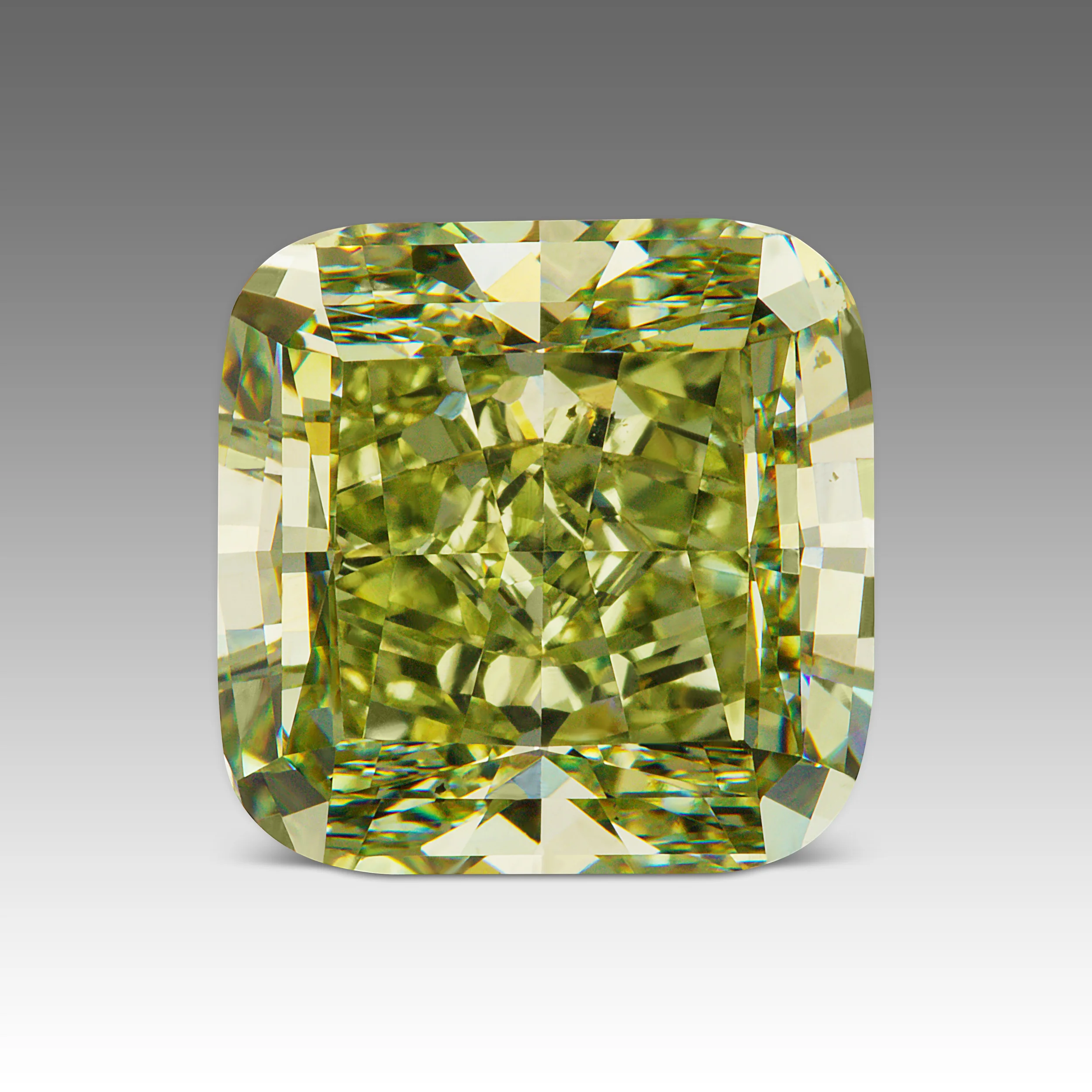"Green is the prime color of the world, and that from which its loveliness arises." -- Pedro Calderon de la Barca
In the world of fancy coloured diamonds, a green diamond may be the most mysterious and intriguing!
Can you imagine how our world would look like without the color green? Green is the color of life, nature, environment, renewal and harmony.
It's not very often that you come across natural green diamonds. In my design career, I am fortunate to work with some of the most gorgeous fancy colored exceptional diamonds. And yet, I can only count a handful of green diamonds that I have had the privilege to design around. The largest of green diamonds that I have worked with so far is an exceptional Greenish-Yellow diamond, weighing 8.60 carat. What I find is that people who ask for and buy green diamonds have a great sense of their own unique individuality and need a stone to match that. They are in the know of coloured diamonds, and appreciate provenance and rarity.
The 'Imperial Diamond Necklace' is designed by award-winning designer Reena Ahluwalia and commissioned by Venus Jewel - World Leaders in Solitaires. Materials: 8.60 ct., Canadian greenish-yellow diamond from Ekati Mine, purplish-pink Argyle Pink Diamonds and white diamonds set in 18k white and rose gold.
Bruno Scarselli, of Scarselli Diamonds in New York is a third generation of the Scarselli family and a fancy color diamonds connoisseur. Bruno tells me, "Green might be one of the greatest color resembling the full beauty of nature. Only to imagine natural radiation, deeply penetrating the crystal, is the attribute of color depth within its heart of what creates a green diamond."
Here's my tribute to green diamonds. The Portal of Mystery diamond painting features a cushion cut green diamond. Size 30x30 inches.
I am constantly learning about these mysterious green diamonds and I hope you find this blog post useful.
Green Diamonds
Pure green diamonds are extremely rare and highly valued, ranging from light mint greens to vivid grass greens. Green Diamonds can contain a yellowish, bluish or grayish modifying color. Only a handful of natural green diamonds are introduced into the market each year making green diamonds some of the most sought after of all natural color diamonds. Green diamonds are found predominately in regions of Africa and South America. The strength of color is one of the most important factors in determining the value of a natural color diamond. The value of a natural color diamond increases with the intensity of the most prominent color within the diamond.
Image: NCDIA
Different causes of color in green diamonds produce slightly different hue ranges, depending on the other impurities and defects present. Image credit: GIA, Christopher M. Breeding, Sally Eaton-Magaña, and James E. Shigley
Over the last ten years, diamonds with these natural color components comprised less than 0.4% of all diamonds submitted to GIA’s laboratories worldwide (including both fancy-color and those on the D–Z scale). Pure hues of green, blue, or red are even rarer, accounting for less than 0.07% of all diamonds examined. [Source: GIA]
Modern production of green diamonds has come from mines in Guyana and Brazil (left) as well as Zimbabwe (right). The dark brown to greenish “skins” seen on the surfaces of the rough diamonds are due to radiation damage. Image credit: GIA
The most famous of all green diamonds is the legendary ‘Dresden Green’, a modified pear-shaped bluish apple-green diamond of 41.10 carats. Courtesy: Grünes Gewölbe, Staatliche Kunstsammlungen Dresden.
Optimum Diamonds LLC’s's rare natural fancy color green diamonds from "Gamma" collection. These rare diamonds were exhibited in the Natural History Museum of Los Angeles County (NHMLA) in an exhibition called “Green Diamonds: Natural Radiance”. Image credit: Optimum Diamonds LLC, Copyright ©Digital Jewelry Photography
Natural-color green diamonds such as these rough (0.85–1.07 ct) and faceted (0.68–1.66 ct) stones submitted to GIA by clients or for scientific study are extremely rare and generally found in South America or Africa. Image credit: Photos by various GIA staff.
1.01 Vivid Yellowish Green Diamond. From Optimum Diamonds LLC’s's rare natural fancy color green diamonds "Gamma" collection. Image credit: Optimum Diamonds LLC, Copyright ©Digital Jewelry Photography
1.51 Fancy Vivid Green. From Optimum Diamonds LLC’s's rare natural fancy color green diamonds "Gamma" collection. Image credit: Optimum Diamonds LLC, Copyright ©Digital Jewelry Photography
“The Light of Erasmus", a 1.62 Fancy Vivid Greenish Blue Diamond. From Optimum Diamonds LLC’s's rare natural fancy color green diamonds "Gamma" collection. Image credit: Optimum Diamonds LLC, Copyright ©Digital Jewelry Photography
“The Mantis”, the largest vivid yellowish-green diamond ever graded by the Gemological Institute of America. 4.17ct Vivid Yellowish Green Diamond. From Optimum Diamonds LLC’s's rare natural fancy color green diamonds "Gamma" collection. Image credit: Optimum Diamonds LLC, Copyright ©Digital Jewelry Photography
“The Shangri-La", a 3.88 Fancy Vivid Green diamond from The Optimum Gamma Green Collection, a collection of the most rare and prestigious natural green diamonds in the world, with more than 50 stones accrued over 20 years. Image credit: Optimum Diamonds LLC, Copyright ©Digital Jewelry Photography
A 0.58-carat fancy vivid green diamond. Image credit: Optimum Diamonds LLC, Copyright ©Digital Jewelry Photography
'Aurora Green' is a 5.03 carat Fancy Vivid Green diamond, one of the rarest colour grading for a diamond and the largest of its kind ever to be offered at auction. It was sold for $16.82 million at Christie's auction, Hong Kong on May 31, 2016, making it the most expensive green diamond ever auctioned. "The diamond got its name from the natural phenomenon “aurora borealis” or “aurora australis,” with the diamond’s saturated color and scintillation emulated by the magical display of dancing lights that can only be seen above the magnetic poles of the northern and southern hemispheres. The auroral display appears in a spectrum of colors, but vibrant, vivid greens are the most anticipated and admired. It is only this natural marvel that can fittingly describe the natural wonder that is this diamond." -- Christie’s Vickie Sek. Image: Christie's
Sold for $17 million! Christie’s sold the ‘Aurora Green’ diamond to Chow Tai Fook for $16.8 million (HKD 130 million) at its Hong Kong auction May 2016, achieving $3.3 million per carat.
'Aurora Green' is a 5.03 carat Fancy Vivid Green diamond, one of the rarest colour grading for a diamond and the largest of its kind ever to be offered at auction. Christie's auction, Hong Kong on May 31, 2016. Image: Christie's
Pure green diamonds are extremely rare and highly valued, ranging from light mint greens to vivid grass greens. Green Diamonds can contain a yellowish, bluish or grayish modifying color. Image: Leibish & Co.
A 4.24-ct. natural-color Fancy green diamond surrounded by a suite of yellow to green rough diamonds. Courtesy American Siba Corp. (cut stone), Cora Diamond Corp. (rough crystals). Image: GIA
The color of this marquise-shaped natural green diamond is typical of diamonds in the green color family. Green diamonds, when fashioned as gems, very rarely have a pronounced green body color. Image: GIA
Of natural colored diamonds, green and red diamonds are by far the rarest body colors. The appearance of green in a diamond is caused by millions of years of exposure to a source of natural irradiation in the earth, either among uranium compounds or percolating ground water, which changes its specific absorption of light. The majority of naturally irradiated diamonds show isolated green strains that barely penetrate the surface of the crystal and are almost always removed during the cutting process. Conversely, a very small minority are exposed to the irradiation source over an extended period of time and therefore exhibit an even green hue throughout the entire crystal. Among this extremely select group of stones, only a very few have a true green color without any bluish, greyish or yellowish secondary colours. Natural, true green diamonds are therefore unique gemmological rarities, and represent an extraordinary group of beautiful and mysterious gems.
The most famous of all green diamonds is the legendary ‘Dresden Green’, a modified pear-shaped bluish apple-green diamond of 41.10 carats. Image: GIA
The most famous of all green diamonds is the legendary ‘Dresden Green’, a modified pear-shaped bluish apple-green diamond of 41.10 carats.
The spectacular 41-carat “Dresden Green” diamond, which probably originated in the diamond mines of the Golconda district in India, first appeared in the historical record in 1722. A diamond dealer named Marcus Moses offered it for sale to Friedrich Augustus I (“August the Strong”), elector of Saxony and king of Poland in 1726. His son, Friedrich Augustus II bought the diamond from the Jewish merchant Delles at the Great Annual Easter Fair at Leipzig in 1741. A continuous historical record and provenance has accompanied this extraordinary Rosetta Stone of green diamonds ever since. At the close of World War II, it was taken to Russia by Soviet troops, and then returned to Dresden in 1959 and is now on display in the Jewelry Room of Dresden’s Green Vaults.
In addition to its long history, which predates experiments with artificial irradiation, the Dresden Green is famous because its green color was created by natural radiation and the color is throughout the stone – not just at the surface as is typical of natural green diamonds.
Legendary ‘Dresden Green’, a modified pear-shaped bluish apple-green diamond of 41.10 carats. Courtesy: Grünes Gewölbe, Staatliche Kunstsammlungen Dresden.
Famous Dresden Green Diamond. Credit: Grünes Gewölbe, Staatliche Kunstsammlungen Dresden.
The Ocean Dream Diamond. 5.51-carat, fancy deep blue-green, shield-shaped diamond. The Ocean Dream is the first and one of the only natural diamonds known to the GIA to possess a blue-green hue (besides the Ocean Paradise Diamond owned by the Nahshonov Group, found in Brazil in 2012), making it one of the rarest diamonds in the world. The Ocean Dream originated in Central Africa, and is currently owned by the Cora Diamond Corporation and was cut by Master Cutter Mazhar Saylam.
The Ocean Dream Diamond. 5.51-carat, fancy deep blue-green, shield-shaped diamond.
"The Blue" diamond (L) and "The Ocean Dream" diamond (R) pictured at Christie's Auction House in New York, April 11, 2014. Christie's New York is displaying the largest flawless fancy vivid blue diamond ever to appear at auction. [Image: Christie's / Agencies]
The Chopard Chameleon Diamond. The 31.32 carat oval-cut chameleon diamond is the largest documented stone in this category. Named after the tiny animal that changes colour in order to adapt to the world around it, the chameleon diamond fascinates connoisseurs: its ability to temporarily change colour after heating or long storage in the dark gives it unique status among diamonds. The change in colour of Chameleon diamonds is ephemeral - the original “olive green” colour of the stone shifts into an intense yellow or orange-yellow colour when the stone is kept in the dark for 24 hours or when it is heated to approximately 200 degrees Celcius. It gradually reverts to green when exposed to daylight or as it cools down. The Chameleon diamond is the centerpiece of a ring surrounded by a delicate pavé setting of tiny yellow diamonds. The ring was designed by Caroline Gruosi-Scheufele and was presented at Baselworld 2008. The estimated worth of the stone in 2008 was $10 Million USD.
The Chopard Chameleon Diamond. The 31.32 carat oval-cut chameleon diamond is the largest documented stone in this category.
Claw-set with a cushion modified brilliant-cut fancy vivid green diamond weighing 2.52 carats, to a plain platinum and yellow gold mount. This rare diamond appeared at Sotheby's 2009 Magnificent Jewels action. Image: Getty & Sotheby's
Fancy vivid green diamond weighing 2.52 carats. This rare diamond appeared at Sotheby's 2009 Magnificent Jewels action. Image: Sotheby's
The cushion-shaped fancy intense green diamond weighing 6.13 carats, within a brilliant-cut pink diamond surround, extending to the half-hoop, mounted in 18k rose gold. Image: Christie's
A square-shaped fancy green diamond weighing 10.36 carats, set in a ring within a pear-shaped and round cut pink diamond surround. Image: Christie's Hong Kong, 2008.
A magnificent 3.15 carat, Fancy Intense Yellowish Green diamond. Vs1. Image: Scarselli Diamonds
An outstanding 8.14 carat Fancy Yellowish Green diamond. Image: Scarselli Diamonds
An exceptional 1.56 carat, Fancy Vivid Green Diamond manufactured by A.A Rachminov Diamonds. Image: Ori Vechler, A. A. Rachminov Diamonds.
Blue/green emerald-cut diamond ring by Tiffany & Co.
Tiffany & Co. Ring
A rare green diamond emerges from tiered white diamonds like a cool summer breeze. Radiant-cut Fancy Vivid Green diamond, carat weight 1.21, clarity grade SI2; rose-cut white diamonds, carat total weight 9.20; round brilliant white diamonds, carat total weight 1.25. Image: Tiffany & Co.
Pair of Radiants, fancy green diamonds. Image: Unknown
18.79-carat bluish-green diamond macle featured in the Awakening Lotus Necklace. Image: De Beers Jewellers
A green diamond rough. Image: Unknown
Peregrine Diamond discovers green diamonds at high-grade diamondiferous kimberlite at CH-6. Shown here are green diamond roughs. Image: Peregrine Diamonds / 2017
Source & images:
- The Natural Color Diamond Association (NCDIA)
- Gemological Institute of America (GIA)
- Sotheby's
- Christie's
- NCDIA, Blog by By David Shara and Josh Cohn
- Grünes Gewölbe, Staatliche Kunstsammlungen Dresden.
- Optimum Diamond LLC
- Scarselli Diamonds
- A.A Rachminov Diamonds
- Leibish & Co.
- Tiffany & Co.
- Chopard
- Cora Diamond Corp.
- Peregrine Diamond
- Wikipedia
———
In the past I have authored posts on, Bejeweled Maharaja & Maharani of Mysore, Koh-i-Noor Diamond, Diamonds on World Postage Stamps, Top Ten - Largest Diamonds Discovered In The World, Splendors of Mughal India, The Magnificent Maharajas Of India, Mystery & History Of Marquise Diamond Cut, Ór - Ireland's Gold, The Legendary Cullinan Diamond, Bejeweled Persia - Historic Jewelry From The Qajar Dynasty, Famous Heart-Shaped Diamonds, Type II Diamonds, Green Diamonds, Red Diamonds and more. Over years, I have spent countless hours in self-driven studies on diamond, jewelry history and research. I wrote these blogs for a simple reason - to share my collected knowledge with all who are interested, so that more can benefit from it. Take a look and enjoy! -- Reena









































